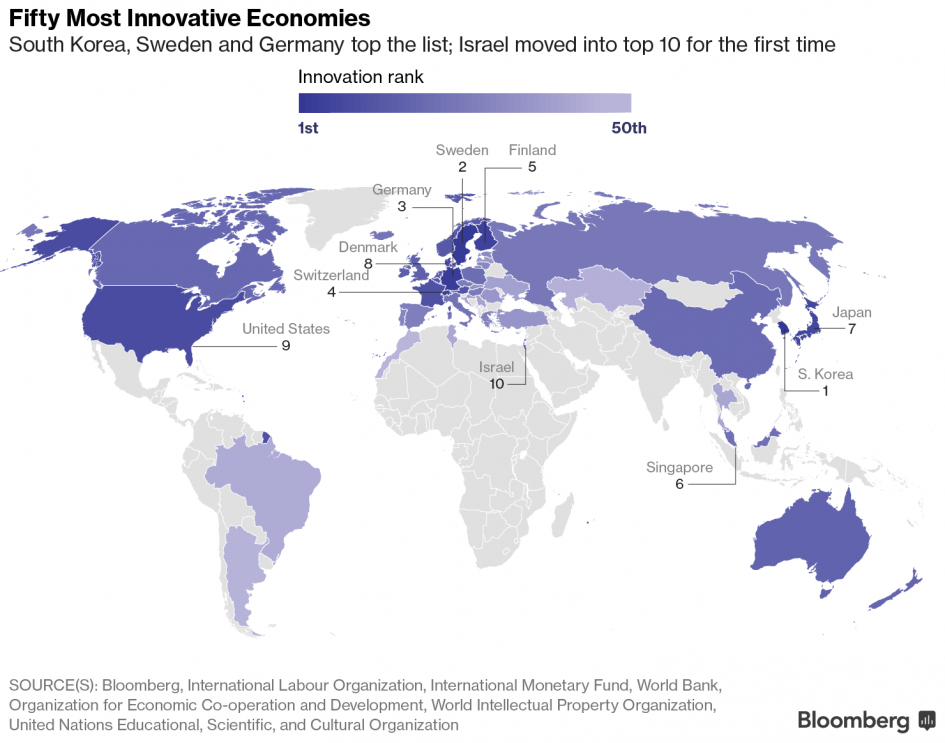Just as one year ago, South Korea took the first place of Bloomberg’s Innovation Index. In this year’s issue of the ranking, Sweden and Germany swapped their positions and were ranked second and third respectively.
Bloomberg’s experts rank countries according to seven criteria. Switzerland demonstrated top 10 results in four of them: productivity (2nd place), patent activity (4th place), manufacturing value-added (6th place) and R&D intensity (8th place).
Here are more details on the criteria of the Index:
1. R&D intensity (share of national GDP spent on R&D projects)
Switzerland spends quite a lot on R&D projects - 3% of its GDP. Moreover, according to data from the Swissmem Association, members of the MEM (Machinery, Electronics and Metal Production) sector generally spend 5% of their revenues on R&D. However, in the knowledge-intensive business environment it is not common to cover such expenses from the pocket of private companies. The government actively provides funds for innovative R&D activities. Switzerland has a well-developed system for collaboration between business and scientific institutions. The Swiss Commission for Technology and Innovations (KTI) covers up to 50% of costs in joint R&D projects launched by private companies and universities. Local companies can use laboratory equipment and scientific workforce while retaining intellectual rights to the outcome. Streamer International AG, a developer of lightning protection systems, launched a joint 2-year project with the Higher Technical School of Rapperswil in 2013. 50% of the costs were covered by a grant from KTI.
2. Manufacturing value-added (as a share of GPD and purchasing power parity per capita)
Today Swiss machinery manufacturers and producers of electrical equipment, electronics and precision measuring instruments are holding leading positions on the global market. The MEM sector gives jobs to over 300,000 people and generates a total annual revenue of USD 90 billion. For additional information about manufacturing in Switzerland please refer to our fact sheet. By the way, this sector is mainly represented by small and medium businesses.
3. Productivity (GDP and GNP referenced to country’s total adult (15+) workforce and its dynamics across recent 3 years)
According to data from the International Monetary Fund for 2015, Switzerland ranks second in the world in terms of its GDP per capita. Swiss GDP per capita is almost twice as high than that of England, France and Germany. The manufacturing sector, one of the country’s major industries, generates almost 27% of the Swiss GDP. Some of the country’s key industries include chemical manufacturing, industrial equipment, and banking. Finally, the Swiss economy is mostly focused on exporting – the country’s share of international trade in terms of its GDP is one of the highest globally.
4. Hi-tech density (share of hi-tech businesses in the total amount of officially registered national enterprises and its share in the global amount of public hi-tech companies; the calculation includes national public companies that represent the following areas: defense and aerospace; biotech; software; computer hardware; semiconductors; web-based software and services; and renewable energy sources)
The success of Switzerland is mainly based on the cluster approach. The country has over 20 major clusters dedicated to particular industries. Biotech enterprises are located in the northwestern part of the country. Manufacturers of precision mechanics and optics are mostly located in the so-called “watchmakers’ belt” between Geneva and Schaffhausen. The financial sector, concentrated in Zurich, gives jobs to over 40,000 people. Industrial equipment enterprises are mostly located in the southern, central and northern cantons. Local ICT industry is also becoming very important for the national economy. All these clusters have leading hi-tech companies located nearby from major universities, so they can work together on the development of innovative technology.
5. Tertiary efficiency (share of university students of all ages compared to total amount of high school graduates; minimal share of university degree holders; share of young STEM professionals compared to total amount of new university degree holders and to total number of the working population)
Switzerland considers education a priority area. The country’s society strongly believes that everybody should have equal education opportunities. Year on year Swiss universities occupy leading positions in global educational ratings. For example, last year ETH (Swiss Federal Institute of Technology in Zurich) and EPFL (Swiss Federal Institute of Technology in Lausanne) were ranked among the world’s top 20 universities by the QS World University Rankings. For additional information about education in Switzerland, please refer to our fact sheet.
6. Researcher concentration (total amount of professionals, including post-graduation students, employed in R&D projects per capita)
Over 50% of the Swiss workforce is employed in knowledge-intensive business, and the country is fourth globally by the number of its Nobel Prize winners (113 laureates).
7. Patent activity (total amount of patent applications filed by country’s residents, number of active patents per capita; number of patent applications per USD 100 million of national GPD and share of national grants to the global amount)
According to data from 2015, Swiss researches were responsible for 873 patents per million inhabitantsone million applications registered by the European Patent Office.
The 2017 Bloomberg Innovation Index is based on information provided by Bloomberg, International Labor Organization, International Monetary Fund, World Bank, Organization for Economic Cooperation and Development, World Intellectual Property Organization and UNESCO.
For additional information about various aspects of doing business in Switzerland refer to our Handbook for Investors.





